Final report for ONE16-282C
Project Information
No farmer wants their cover crops to grow big enough to interfere with their planting operation, but there are some big benefits still to be had from as few as two more weeks of growth past the average burn-down date. These include moisture retention during dry spells, more organic matter, less compaction, more rainwater infiltration, and an increase in the amount of nitrogen that stays in the soil profile. Most recent model planters can easily handle up to several additional weeks of grass cover crop growth.
This project was developed as part of the Northeast SARE Cover Crops Initiative. In March 2016, teams of 10 farmers, educators, researchers and service providers from each Northeast State met in Baltimore, MD to learn about state of the art cover crop management techniques.
The Maryland team developed a demonstration and education project to address the often-missed benefits of delayed cover crop termination, primarily in the ~300,000 acres of single species grass cover crops per year. The project established demonstrations on 3 privately owned farms where a strip of cover crops was allowed to grow 2-4 additional weeks past the normal kill date. Each site hosted a spring field demo in 2017 with 55 total participants. These demos showed that planting into green residue is quite possible, and all farmers reported no significant issues. The field demos also provided an opportunity to present a hands-on exercise in measuring field soil health with the Maryland Soil Health Card. A field demo in the late summer at one of the farms allowed another 55 participants to examine the corn growth and remaining cover crop residue side by side with the control treatment, and also to learn from researchers running a related NRCS Conservation Innovation Grant project.
While these demonstrations were only intended as an opportunity for field-based learning and discussion rather than replicated and statistically significant results, the yield results that are available are inconclusive. Most show no obvious difference between the treatments, possibly because the weather conditions most likely to produce a benefit from delayed termination are a long dry summer on non-irrigated land, and these conditions did not occur during the trial. In one case there seemed to be a yield loss as a result of the delayed termination, possibly due to increased shading from the additional cover crop residue. It is important to note that potential long-term soil health benefits like an increase in organic matter (and all of its many related benefits) and infiltration are beyond the scope of this project.
A "soil health self-evaluation tool" began as a tangential component of the project, but eventually became an important stand-alone product. This online questionnaire-based tool allows farmers to receive automated feedback on their farming practices in each of 14 categories in terms of improving soil health. It is currently in pilot form and its finalization and official release will continue through a related Northeast SARE project. Four classroom presentations focusing on the use and outreach of this tool totaled 149 participants. At the 2017 Mid-Atlantic Soil Health Conference in Pennsylvania, the two farmers hosting field tours each completed the questionnaire and spoke about their impressions with the 157 participants.
This project will identify one farmer in the geographical center of each of four regions where grain production is prevalent: West Central (Frederick or Carroll Counties), Southern (Prince George’s or Anne Arundel counties), the Upper Shore (Cecil or Kent counties) and the Lower Shore (Dorchester, Talbot, or Caroline counties) to serve as leaders by example. These farmers will have conventional operations representative of the typical grain farm in their region, primarily with a corn and soybean rotation. One of the Eastern Shore demonstration sites will have poultry litter application in its management regime. Farmers currently practicing early kill will be preferred so that they can provide feedback on how the changes worked for them. Recruitment of demonstration farmers will be conducted in partnership with Steve Mirsky (USDA ARS), who is beginning a large cover crop NRCS Conservation Innovation Grant (CIG) project.
Each farmer will agree to establish one demonstration field in each year of the two year project. The second year field may be in a different location from the first year field. Demonstration fields will be at least 5 acres in size. Farmers will establish strips in the demonstration fields, one control and two treatment strips. Strips will be as wide as the spray boom used by the farmer. The control strips (typical termination practice) will be sprayed between March 1 and April 15 of 2017 and 2018. One treatment will be the absence of cover crops, as required by the CIG project experimental design. The other treatment will be the delayed burndown of the grass cover crop, sprayed any time after May 1.
Project educational activities will revolve around four events each in the spring and mid-summer, per year over two years, for 16 workshops total. An informal video of the planting and the mid-summer results will be developed, posted on YouTube, shared through social media sites, and posted on the UMD Extension Soil Health webpage. A brief fact sheet will also be developed with photos and project results.
In addition to the field days, demonstration farmers will be encouraged to speak about their successes and challenges with their informal network of farmer contacts.
Maryland has the distinction of being one of the only states in the country to offer an incentive program for planting cover crops. With funding from Maryland Agricultural Water Quality Cost-Share Program (MACS), this program pays farmers between $25 and $75/acre to plant cover crops, which can add up to a lucrative winter enterprise. Of the almost half a million acres spring certified in cover crops under the program in fall of 2014, 65% (306,996 acres) were planted with a single variety of grass. MACS funds this incentive program because cover crops scavenge nitrogen in the winter that would otherwise leach away from the field and eventually enter the Chesapeake Bay estuary, leading to a variety of water quality problems. Grass cover crops are the most effective in scavenging nitrogen and therefore qualify for the highest incentive payment rates.
In order to qualify for the payment, cover crops must be planted by a certain date (with a bonus payment for an earlier date), and maintained until March 1 of the following year, at which point they may be killed. Many program participants kill their cover crops soon after the March 1 threshold, even though farmers may wait as long as June 1 and still comply with the program. The reasons are two-fold: they don’t want the cover crops to grow to the point at which they will interfere with their planting operation, and/or they assume that they’ve already received the maximum agronomic benefit from the cover crops and that there is no benefit to allowing them to grow further. Unfortunately, both lines of thinking are incorrect. Most recent model planters can easily handle up to several additional weeks of grass cover crop growth, and there are several substantial benefits still to be had from as few as two more weeks of growth. These include moisture retention during dry spells, increased organic matter with its suite of services, increased root action contributions like reducing compaction and increasing infiltration, and an increase in the amount of N retained in the soil profile (Teasdale and Mirsky, accepted; Mirsky et al., 2013; Nord et al., 2012; Nord et al., 2011; Ryan et al., 2011; Clark et al., 1997). Therefore, a large number of farmers, farm acres, and watersheds would benefit from the potential yield boost and reduction in leached nutrients available from delayed spring cover crop burndown.
This project addressed this incremental step in ushering Maryland’s farmers toward greater understanding, appreciation, and adoption of advanced cover crop practices. Through a program of extension and outreach demonstrations, activities, and materials, this project helped farmers see first-hand the benefits of allowing cover crop rye and other grasses to grow past the program minimum kill date.
Cooperators
Research
Accomplishments
2016
In the first four months of this project, several steps were taken towards the project objective. The project team met by phone to plan the details of the first steps of the project. The team leader, Nevin Dawson, worked closely with the Conservation Innovation Grant (CIG) project to recruit farmers for participation in their project, which is a prerequisite for participation in this SARE project. Dawson spoke at a recruitment program for farmers, contacted his farmer contacts across the state with this flyer, and sent a broadcast text to all cover crop incentive program participants in Caroline County. These efforts resulted in 7 farmer recruits for the CIG project. Of the 11 total farmers recruited for the CIG project (several with multiple fields), the SARE project team will identify 4 to invite to participate as demonstration farmers for this SARE project. The project team will meet again by phone in January to select these four farmers based on their geographical location, their practices, and their likelihood of enthusiastic participation.
Substantial progress was also made on the soil health self-evaluation tool. Dawson and Travis Martin worked closely with the authors of "Soil Health in field and forage crop production," Sjoerd Duiker, Lisa Blazure, and Joel Myers, to develop a draft of the tool. This sub-committee met by phone and in person to develop the set of multiple choice questions based on the 14 criteria for good soil health management described in the publication. The sub-committee also developed a corresponding scoring rubric that generates an overall soil health management score, as well as sub-scores for each of the 14 criteria. Users will also receive a report with a spiderweb (or radar) graph that will visually highlight areas of good management and areas with room for improvement. After some refinements, the tool will be ready for field testing in early 2017.
- Summer Identify 4 farmer collaborators [Dawson, Mirsky, NRCS field staff]
- Completed (2017) – Identifying farmers meeting the criteria was not possible in the exact regions defined by the proposal. Collaborators are as follows:
- Lower Shore: Gary King’s Farm, Somerset Co.
- West Central Western MD: Leslie Bowman’s Farm, Franklin Co., PA (just across the state border from Washington Co., MD)
- Southern Central: Clear Meadow Farm (Greg and Zack Rose), Harford Co.
- Upper Shore Mid-Shore: Jim Lewis’ Farm, Caroline Co.
- Aug-Oct Work with farmer collaborators on field selection and treatment/control strip layout [Richards, Mirsky, Weil]
- Completed
- Completed (2017) – Identifying farmers meeting the criteria was not possible in the exact regions defined by the proposal. Collaborators are as follows:
2017
The project built up momentum this year, although also faced some challenges. Identifying farmers meeting the criteria was not possible in the exact regions defined by the proposal. Of the farmers recruited for participation in the CIG project, 3 (King, Rose, and Lewis) were identified to host demonstration strips in Maryland, and 1 (Bowman) who already plants green was identified to host a spring field walk on his farm 15 miles north of Maryland in Pennsylvania. Three of the spring demonstrations had good attendance (55 total; 37 ASPs, 18 farmers) considering the scheduling by necessity during planting season. The Bowman farm had insufficient registration numbers and was cancelled. All host farmers spoke and reported no significant issues with running a planter through the green cover crops with increased height and biomass. Dawson demonstrated the use of the NRCS Maryland Soil Health card in addition to covering the content about planting green. As expected, lining up the timing and logistics of planting with the timing of the workshops proved difficult, and only one event (Clear Meadow Farm) featured an actual planting demonstration. This was filmed by The Mill’s marketing staff and was aired nationally on RFD TV as part of Hushon’s update.
Dawson worked with Hushon to add a new afternoon segment to The Mill’s annual Crop Showcase in September at Clear Meadow Farm focusing on this project. The events were advertised both jointly and separately. The other three planned fall events were not scheduled, in part due to the crowded field of similar soil health events throughout Maryland.
The sub-committee working on the soil health self-evaluation tool also made significant progress, described below.
- Jan-Feb create agreement with custom spray operators [Dawson]
- This has not been necessary so far, as collaborators have done their own spraying, or have developed an informal arrangement with a neighbor.
- Mar 1-Apr 15 Control strips sprayed [Demo farmers]
- Completed
- Mar - Aug Photo documentation [local SCD/NRCS office]
- Partially complete – Logistics of frequent field visits were difficult to arrange. More photos throughout the growing season should be possible in 2018.
- May 1 or later Treatment strips sprayed [Demo farmers]
- Completed
- May Planting demonstration at each of 4 farms [Demo farmers]. All four events were advertised with this flyer and agenda through a variety of local and statewide email, newsletter, and social media channels reaching at least several hundred ag service providers and farmers. A variety of continuing education credits were offered as an additional incentive for attendance
- Lower Shore: Gary King’s Farm, Somerset Co.
- Completed: April 27, 2017; 13 ASPs, 3 farmers
- The event was profiled by The Lancaster Farmer newspaper in this article.
- Western MD: Leslie Bowman’s Farm, Franklin Co.,
- Incomplete: Scheduled and advertised for May 5, 2017, but registration numbers were too low to justify holding the workshop
- Central: Clear Meadow Farm, Harford Co.
- Completed: April 18, 2017; 7 ASPs, 7 farmers
- Mid-Shore: Jim Lewis’ Farm, Caroline Co.
- Completed: May 10, 2017; 17 ASPs, 8 farmers
- The event was profiled by The Delmarva Farmer newspaper's Crop Management Report in this article.
- Jul-Aug Field day at each of 4 farms to demonstrate treatment effects
- Lower Shore: Gary King’s Farm, Somerset Co.
- Incomplete: the availability of several other closely related programs precluded the need for this separate program
- Western MD: Leslie Bowman’s Farm, Franklin Co.,
- Incomplete: the availability of several other closely related programs precluded the need for this separate program
- Central: Clear Meadow Farm, Harford Co.
- Completed: Held on September 9, 2017 as an additional afternoon program after The Mill’s annual Crop Showcase; The Mill provided tents, chairs, and coordinated wagon transportation to the field site; advertised in part with this flyer; A variety of continuing education credits were offered as an additional incentive for attendance; Full day agenda; 33 ASPs, 22 farmers
- Mid-Shore: Jim Lewis’ Farm, Caroline Co.
- Incomplete: the availability of several other closely related programs precluded the need for this separate program
- Sep Debrief with 4 demonstration farmers [Dawson]; Work with farmer collaborators on field selection and treatment/control strip layout [Richards, Mirsky, Weil]
- Complete
- Aug-Dec Development of Materials
- Fact Sheet [Dawson]
- Incomplete: Insufficient data and conclusions
- Video [NRCS Public Relations staff and/or Dawson]
- Complete: The Mill’s marketing staff created a video of the spring planting demonstration that was broadcast nationally on RFD TV and is available on YouTube: https://youtu.be/6G9LRrRBsAU?t=2m37s
- Self-evaluation [Martin]
- In progress: the sub-committee met by phone to refine the weighting rubric used to give respondents scores in each category as well as an overall score; Dawson wrote formulas allowing Qualtrics to calculate these scores and display them to the respondent automatically
- A pilot version (http://ter.ps/SHeval) has been released on a limited scale and has been completed by 29 respondents so far. Continuation of this project component is included in the PI’s Northeast SARE state project, NEUMD17-001, “Building Soil Health in Maryland through Agricultural Service Provider Education.” This product was proposed as just a small addition to this project, but it has grown to become an important tool with high potential to help farmers understand their soil health management options.
- Dawson has promoted this tool at numerous events, in particular the Mid-Atlantic Soil Health Conference on 10/17/17 and 10/18/17: each of the two field visit host farmers used the self-evaluation ahead of the event, and Dawson presented and discussed the results to the 110 ASPs and 47 farmers in attendance
- Live Soil Health Self-Evaluation Tool (Qualtrics survey)
- Soil Health Self Evaluation Preview (PDF)
- Score Weighting Rubric (PDF)
- Dec Distribute follow-up survey to field day participants [Dawson]
- Complete: 25 project participants responded
- Fact Sheet [Dawson]
- Lower Shore: Gary King’s Farm, Somerset Co.
- Lower Shore: Gary King’s Farm, Somerset Co.
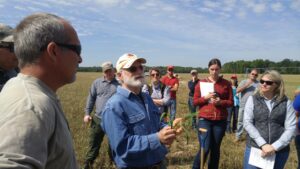
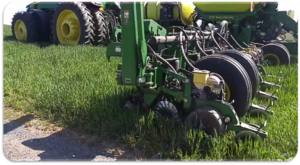
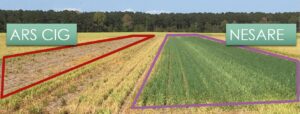
2018
2018 was a difficult year for Maryland farmers with unusual patterns of rain, including record totals and heavy spring rains that caused delayed and failed plantings. These circumstances interfered with the participation of the Roses in both the CIG project and this project. Gary King decided to seed his cover crop aerially this year, meaning that he couldn’t leave a strip bare of cover crops for the CIG project (due to the relative inaccuracy of flying on seed compared to drilling seed) and therefore didn’t participate in this project either. Additionally, the project leader (Dawson) took on new duties unrelated to the project during the project period and had less time available to work towards project goals. Dawson attended the national SARE conference in St. Louis and presented a poster on 4/4/18 that included a sidebar about this project.
Although not included in the proposed timeline, work continued on the soil health self-evaluation tool. Dawson described the tool and invited participants to use it and to invite others to use it in four presentations with totals of 62 ASPs and 32 farmers. Four classroom presentations focusing on the use and outreach of this tool totaled 149 participants (58 farmers and 91 ASPs).
- Jan-Feb Renew agreement with custom spray operators [Dawson]
- This has not been necessary, as collaborators have done their own spraying, or have developed an informal arrangement with a neighbor.
- Mar 1-Apr 15 Control strips sprayed [Demo Farmers]
- Complete (Lewis farm only)
- May 1 or later Treatment strips sprayed [Demo Farmers]
- May Planting demonstration at each of 4 farms
- Lower Shore: Gary King’s Farm, Somerset Co.
- Incomplete (see above)
- Western MD: Leslie Bowman’s Farm, Franklin Co.,
- Incomplete (see above)
- Central: Clear Meadow Farm, Harford Co.
- Incomplete (see above)
- Mid-Shore: Jim Lewis’ Farm, Caroline Co.
- Incomplete (see above)
- Lower Shore: Gary King’s Farm, Somerset Co.
- Jun Distribute follow-up survey to field day participants [Dawson]
- Combined with year-end survey (see below)
- Jul-Aug Field day at each of 4 farms to demonstrate treatment effects
- Lower Shore: Gary King’s Farm, Somerset Co.
- Incomplete (see above)
- Western MD: Leslie Bowman’s Farm, Franklin Co.,
- Incomplete (see above)
- Central: Clear Meadow Farm, Harford Co.
- Incomplete (see above)
- Mid-Shore: Jim Lewis’ Farm, Caroline Co.
- Incomplete (see above)
- Lower Shore: Gary King’s Farm, Somerset Co.
- Sep Debrief with 4 demonstration farmers [Dawson]
- Complete
- Dec Distribute follow-up survey to field day participants [Dawson]
- Complete; 6 responses
Lewis farm photos (2018)
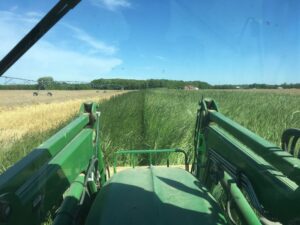
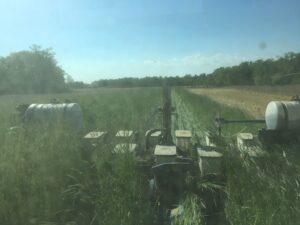
Planting corn into rye Corn in rye (5/9/18)
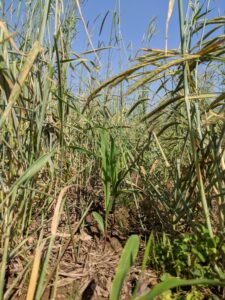
Corn in killed rye Corn in rye (5/25/18)
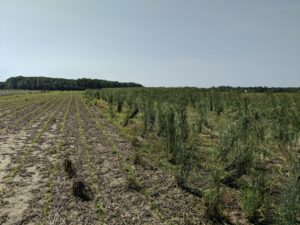
Corn in rye (5/25/18)
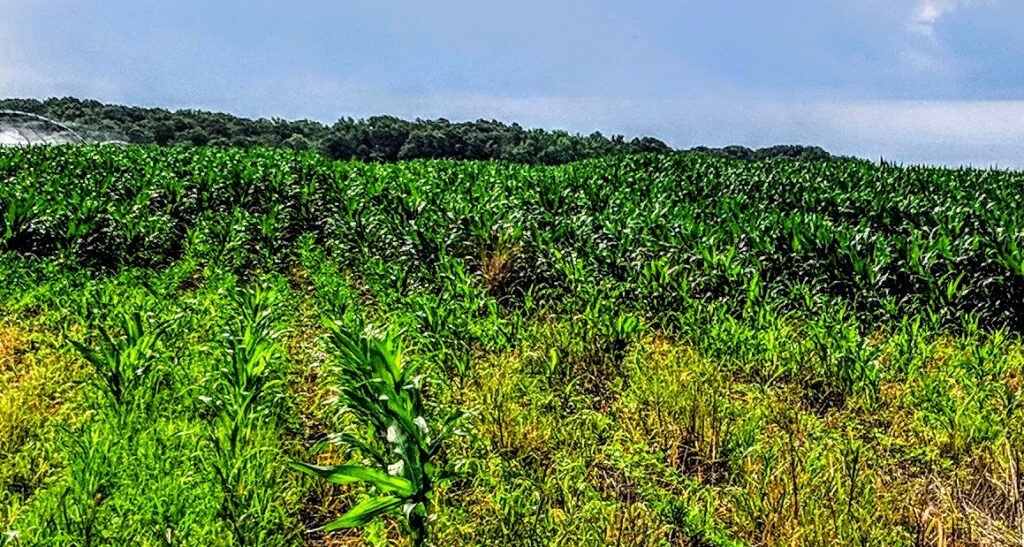
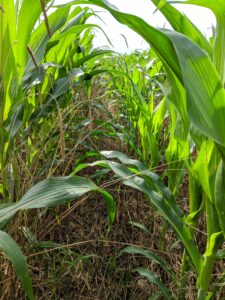
Rye residue in corn after late termination (7/6/18)
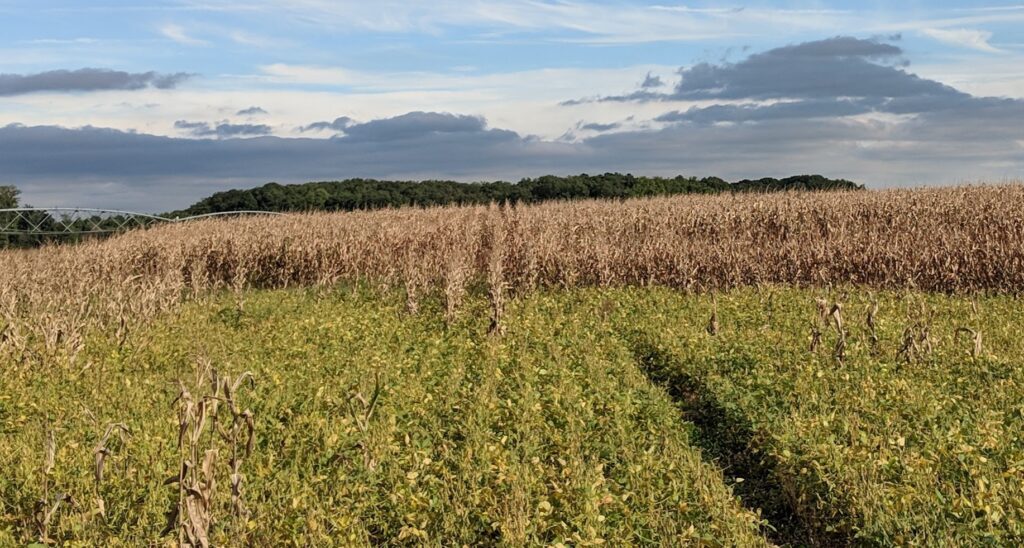
Table 1. Yield data for field corn planted after grass cover crop. ^40 lb/ac extra nitrogen applied at sidedress on 6/6/18 in addition to 160 lb/ac applied to entire field.
|
|
|
|
|
|
Field corn yield (bu/ac) |
|||
|
|
|
Cover Crop |
Corn Planting Date |
No Cover |
Normal kill |
Delayed kill |
||
|
Year |
Farmer |
|
|
|
Kill Date |
Yield |
Kill Date |
Yield |
|
2017 |
Lewis (irrigated) |
wheat |
4/20/17 |
254 |
4/15/17 |
247 |
4/29/17 |
243 |
|
King (dryland) |
wheat |
4/20/17 |
221 |
4/3/17 |
217 |
4/24/17 |
188 |
|
|
Rose (dryland) |
barley |
4/18/17 |
|
3/25/17 |
|
4/29/17 |
|
|
|
2018 |
Lewis (irrigated) |
cereal rye |
5/9/18 |
252 |
4/22/18 |
248 |
5/25/18 |
224^ |
With respect to 2017 results, Jim Lewis remarked, “That’s not enough difference for me to say there is any difference between one treatment and another, especially with no replication.”
According to Ray Weil, “I think this year [2017] had good rainfall and several Farmers have told me that delaying the kill reduced yields because they didn't get a water conservation benefit but they did get a nitrogen penalty if they used a cereal cover crop.”
Gary King said that on his 2017 demo plot, the corn that was planted into late terminated wheat was taller than the other treatments when 6-8" tall, maybe due to surrounding shade from additional wheat residue. He was therefore surprised that this corn had a much lower yield.
In 2018 Lewis noted that there was no significant slug damage to corn despite the additional slug habitat provided by the increased cover crop residue, perhaps because the rye residue also provided a sufficient food source. Lewis also said, “I think the lower [corn] yield is from the rye competition for light. If corn is determining ear size when it is small, it had all that rye as neighbors. I think similar to when you have too high [corn] population [you] get smaller ears.” In response, Weil said, “I agree with you about the early shading of corn. Having a roller crimper on the planter would help a lot with that.” While this may be true, it is important to remember that this would increase fuel costs and carbon footprint to some extent. Lewis was fairly confident that the extra 40 lb/ac of nitrogen applied to the delayed termination strip at sidedress was enough to compensate for any nitrogen taken up by the decomposition of the additional cover crop residue.
Lewis also noted, “There were broken off [corn] plants in the [delayed kill] rye, the only place in entire field.”
It is important to note that this project was designed for demonstration purposes, and not with statistically significant research results in mind. While these anecdotal data do not suggest that delayed grass cover crop termination leads to increased yields in field corn, they are also very limited in scope and have no replications. Also, the wet growing seasons and irrigated field (Lewis) were not ideal for showcasing the potential water conservation benefit that the increased cover crop residue may have. Long term benefits like increased organic matter and other soil health factors may indeed have begun accumulating in the demo sites, but their measurement is beyond the scope of this project.
Education & Outreach Activities and Participation Summary
Participation Summary:
In addition to the activities described above, Dawson added an afternoon session to a dairy manure injection field day on an organic dairy/forage farm. In addition to a guest speaker (Dave Wilson, Penn State Extension) who addressed the challenges of building soil health in organic systems, Dawson presented the soil health self-evaluation tool. Dawson also presented the tool among other topics in a webinar, and during several talks after the project end date (participant numbers not included above).
Learning Outcomes
Because the delayed cover crop termination treatments showed either no difference or a corn yield penalty, the demo site host farmers do not intend to try the same practice again without modifications.
Gary King said that the wheat cover crop can act like a weed when it's still green as corn emerges. He would like to see 3 or more test strips across Maryland over 2-3 years with an average yield boost of at least 5 bu/ac before trying the same practice again.
Jim Lewis said that he'd consider trying it again if he had a roller/crimper to more effectively flatten the rye and perhaps lessen the shading effect on the corn seedlings, although he is concerned about the additional impact on his operation's carbon footprint.
Greg Rose would like to try late termination of a cover crop species mix.
Project Outcomes
Impacts
The field portion of the project had inconclusive results, but participating farmers did witness several conditions in which delayed cover crop termination does not produce any obvious yield advantage. The work on the self-evaluation portion of the project has served as the basis for a grant proposal (unfunded) submitted to the Northeast Extension Risk Management Education Program, which would have allowed for in-depth field testing across Maryland and Eastern Pennsylvania, as well as a series of educational workshops in Pennsylvania, beyond the series already funded by this SARE project. This project also dovetails with Dawson's Northeast SARE Maryland state PDP project (https://projects.sare.org/sare_project/neumd17-001/), which will continue development, outreach, and maintenance of the soil health self-evaluation tool.
As expected, farmers under many different time constraints during planting season are often unable to complete certain operations on the exact schedule that would work best for a demonstration and education project. This meant that including a demonstration of a planter running through green cover crops could not be a part of most of the spring programs, and also that the height and biomass of the cover crop varied widely from site to site, creating very different growing conditions for the corn cash crop.
The selection of a demonstration site with irrigation was likely not a good choice in retrospect. The benefit of the practice that would mostly likely be visible in one growing season, soil moisture retention during a long dry spell, is moot when the farmer can simply turn on the irrigation system to address the problem.
There is still a need for much work on this topic. While some farmers have already adopted delayed cover crop termination, many farmers still need to see more evidence of consistent and/or long-term yield increases as a result. Recommendations for an increase in nitrogen application to compensate for uptake during increased cover crop decomposition should also be developed, along with an economic analysis showing whether yield improvements can cover this additional expense over both the short and long terms.